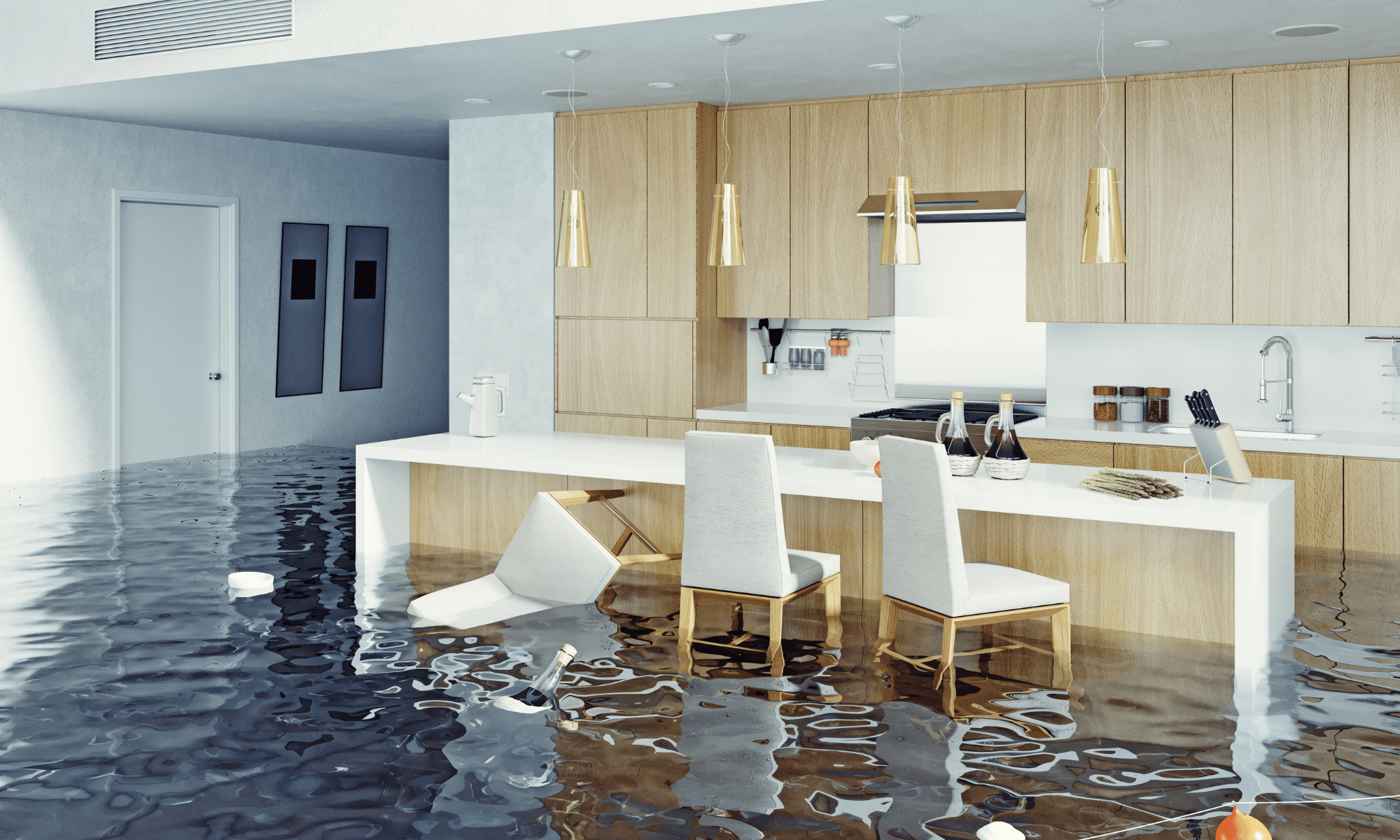The Ultimate Guide to Flood Preparation
Because floods can happen anywhere in the U.S. and virtually any time of the year, it’s essential to be prepared. Storms, clogged storm drains, or even dam malfunctions can cause flooding, so the risk is not strictly weather-based. But preparations for the most common types of flooding can be easily performed on your home to give you and your family some peace of mind, should the worst happen.

Read on to learn how to prepare your home for a flood!
Know Your Area: Flood Warnings and Flood Hazard Analysis
One of the essential steps to minimizing flood damage is appropriate preparation before the event even occurs, and this is not relegated only to aspects of your physical home. Knowledge is power, and if you understand the preludes to floods, you will be better off—such as the tiers of flood warnings and the assessment of flood hazard potentials.
Warning Types
Being able to identify the level of danger associated with national flood warnings is key to being prepared and reacting to the situation appropriately. These warnings include:
Flash Flood Warning
A flash flood warning is a short-term warning, signifying worsening flood conditions that pose an imminent threat to life or property. If you see this warning and live in a flood-prone area, you need to take immediate and preemptive action, such as transitioning to higher ground.
Areal Flood Warning
This is a medium-length warning that will typically last a few hours and covers a wide area that may be experiencing flood conditions. Vulnerable areas include streams, fields, low-lying areas, and marshes, possibly causing road or highway closures. These warnings are often issued immediately following a Flash Flood Warning to indicate an ongoing, but not volatile, flooding threat. Residents of these areas should prepare for high water in places that typically experience flooding.
River Flood Warning
The warning is issued when river rises are expected to crest above flooding stages and may be in effect for days at a time. These warnings affect areas immediately surrounding the established course of a river and are issued based on the various points where the National Weather Service and United States Geological Survey gauges measure the waterway’s height and flooding potential. People who live near the affected rivers need to take appropriate action, including potential evacuation, depending on where their property lies across the river’s floodplain.
Flood Hazard Analysis
Assessing your property and the surrounding area for flood exposure and potential flood damage is key, including consideration of the following:
- Access roads to your property that are susceptible to flooding and that could create problems for exiting or entering the property
- Areas where water runoff can accumulate
- Documented nearby flood sources, like creeks, canals, drainage ditches, elevated reservoirs or dams, groundwater, lakes, oceans, rivers, streams, etc.
- Flood maps that indicate your property is in an active flood plain
- Historical flooding events
- Sewer or drain lines where water can back up into buildings
Steps to Prepare your Home for a Flood
By following these steps, you can easily prepare your home and property for the potential of a flood.
Anchor Fuel Tanks
If your home has unanchored fuel tanks, they are a flood hazard. Interior tanks need to be secured in your basement so they cannot be torn free by floodwaters. Exterior tanks need to be anchored tightly in place to prevent being swept away and causing damage to other houses, water contamination, or even explosions from contact with downed power lines.
Backup Water Supplies
One of the key considerations in the aftermath of a flood is drinking water. Do not drink water from your well or even from city water systems directly after a flood until the water has been tested by the local health department and verified as safe. Untested water risks contamination by chemicals, oil and gas fluids, or bacteria such as E. coli. To avoid this, store 5-gallon bottles of water in a handy location or install an advanced water filtration system that will render most forms of water drinkable for humans.
Fit Backflow Valves or Plugs
To prevent floodwaters from entering through house drains, toilets, sinks, appliances, or other sewer connections, talk to a plumber about installing the correct backflow valves and plugs. Because floodwaters can cause sewers and storm drains to back up, forcing sewage and muck into your washing machine, bathtubs, sinks, dishwashers, toilets, and more, you might experience overflow throughout your house. Installing the proper sewer and waterline equipment will help guard against this!
Flood Defenses
Make sure that you have various flooding defenses on hand and know how to properly apply them. For instance, airbricks, sandbags, plastic liners, tarps, and plastic sheeting are all essential for reducing and redirecting water flow to prevent as much home flooding as possible. Make sure you have these defense products ready and that everyone in the family knows how to use them! You can also install large-scale floodgate systems for your property that utilize barriers and diversions to shepherd flooding away from your home’s foundation and entrances.
Have a Backup Toilet System
Because using septic systems during and after a flood is inadvisable, having a backup system for septic waste is important. From porta-potties to a 5-gallon bucket with heavy-duty trash bags, this system can be as advanced as your situation requires. Because you won’t be able to flush your toilets properly, ensure that you have sanitation liners for covering toilet bowls to keep the spread of bacteria and odors at a minimum until septic systems are functioning normally again.
Install Septic Pump Alarms
Thanks to modern technology, you can install alarm systems that will alert you to flooding before it becomes a major issue. These alarms will let you know if floodwaters compromise your septic system—in which case, toilets should not be flushed, and tanks should not be used or pumped out until the floodwaters have retreated and an expert has examined the systems. If your septic system has become flooded, it is more likely to back up into your house or fail, so these alarms will alert you to any issues of this nature.
Purchase and Install Sump Pumps with Backup Power Sources
Sump pumps are essential for dealing with water accumulation where it shouldn’t be—including groundwater flooding, seepage, and rainfall. Installing a sump pump helps keep your property dry even through flooding, and because floodwaters can knock out electrical power for a considerable amount of time, you should get pumps that are powered by batteries or alternative power sources. If the power goes out, pumps that run solely on an electrical current will not last as long as those designed for a 12-volt battery.
Raise Your Electrical Components
Suppose your home is in an area susceptible to flooding. In that case, it’s a good idea to have a licensed electrician raise your electrical components at least 12” above the projected flood elevation of your location. This includes any circuit breakers, switches, sockets, or wiring, particularly in the basement or on the ground floor. Not only will this prevent electrocution in case of floodwaters, but it will protect your electrical components from water damage.
Stock Up on Supplies
Consider what you might need if you are forced to live in your home without access to shopping outlets for a while after flooding. You should always have battery-operated flashlights, canned food, drinking water, extra batteries, medications, and medical supplies ready in your home. Ensure you have enough to last you and your family for at least three full days.
Waterproof Your Basement and Any Entrances
If you preemptively waterproof your basement or the lowest levels of your house, you can significantly reduce the damage incurred by a flood. Make sure that your gutters and storm drains are clear to facilitate easy water removal. Your property slope should also be angled to divert water away from the home, especially to direct water flow from window wells and entrances to help protect against extreme flooding in your lower level.
Make Your Flooding Checklist
Having an easily accessible checklist of the immediate steps to take in the event of flooding is essential to dealing with the situation calmly and methodically. Here are some things to add to your flooding checklist:
- Fill jugs and saucepans with fresh water and store them in a safe place.
- Fit any flood protection and defense items into place if you have them, such as sandbags, air brick covers, etc.
- Have a plan for salvage and recovery, including a list of contractors, locksmiths, and salvage services.
- Have an accessible list of personal contacts stored on your mobile device and in physical form if your device runs out of battery.
- Have your emergency flood kit in grabbing distance.
- If you do not have backflow or non-return valves fitted, plug up your water inlet pipes with towels or cloths.
- Keep important personal items and documents in sealed bags and containers away from floodwater levels and handy to be taken in a hurry.
- Know the assigned roles for emergency organizations and other responsibilities among family members.
- Know your evacuation route that does not include walking or driving through floodwater, as only a few inches of fast-moving water can easily shift adults and cars.
- Put plugs in the sinks and bathtubs and weigh them down with plastic bags full of soil or rocks.
- Secure all outdoor items that cannot be relocated or are not anchored.
- Store garden tools and ladders away from sight, as they could be used by burglars taking advantage of the confusion during a flood.
- Turn off your gas, electricity, and water before flooding enters your home. Do not touch electrical sources while standing in any depth of water.
Prepare an Emergency Flood Kit
Your flood kit should include all essentials that will allow your family to safely evacuate the home and still have the necessary supplies and items. Things to put into your flood kit include:
- Bank cards and money
- Bottled water
- Can opener
- Extra batteries
- Extra device chargers
- First aid kit
- Flares
- Flashlights
- Heavy-duty trash bags
- Insurance and ownership documents
- Licenses
- Necessary medications
- Non-perishable foods, such as canned goods
- Pet food and leashes
- Portable radio
- Rubber gloves
- Space blankets
- Waterproof clothing, such as jackets and boots
Your emergency flood kit will vary depending on your family’s size and needs, but it’s a good idea to keep it all packed up and in a handy location, just in case you need to evacuate your home quickly. This will be one less hassle during a stressful situation!
For more helpful tips on preparing for a natural disaster, check out how to prepare for a tornado.



